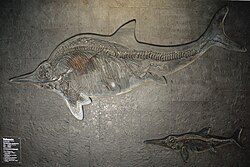Stenopterygius
|
Stenopterygius Temporal range: Early Jurassic, 183–179 Ma |
|
|---|---|
 |
|
| Stenopterygius quadriscissus | |
| Scientific classification | |
| Kingdom: | Animalia |
| Phylum: | Chordata |
| Class: | Reptilia |
| Order: | †Ichthyosauria |
| Family: | †Stenopterygiidae |
| Genus: |
†Stenopterygius Jaekel, 1904 |
| Species | |
|
|
Stenopterygius is an extinct genus of thunnosaur ichthyosaur known from Europe (England, France, Germany, Luxembourg and Switzerland). Maximum length was 4 meters (13 feet).
Stenopterygius was physically similar to the better known Ichthyosaurus, but had a smaller skull and narrower flippers. Beautifully preserved fossils of Stenopterygius have been found in Germany. Its skull was extended into a kind of a beak and was armed with a quantity of large teeth. The limbs had been transformed to fin-like structures. The tail terminated in a large, semicircular, leathery, vertical caudal fin and even a triangular dorsal fin was present.
The habits of Stenopterygius were similar to those of present-day dolphins. It spent most of its life in the open sea, where it hunted fish, cephalopods and other animals. The abdominal cavity of skeletons of this ichthyosaur often contains the remains of such food.
One famous fossil is that of a mother and baby that died in childbirth (ichthyosaurs were viviparous). This proved that ichthyosaur infants were born tail-first, just like cetaceans, to prevent them from drowning before fully clearing the birth canal.
Stenopterygius was a very fast swimmer, with a cruising speed similar to that of tuna, which is among the fastest of all living fishes.
Most of the known specimens of Stenopterygius, more than 100, were recently redescribed by Michael W. Maisch. He found that S. quadriscissus (the type species) also includes S. eos, S. incessus and S. macrophasma, as well as specimens previously referred to S. hauffianus and S. megacephalus. Maisch followed Woodward (1932) and considered Ichthyosaurus triscissus to be a valid species of Stenopterygius. The type specimens of S. longifrons, S. megacephalus, and S. megalorhinus were all referred to this species as the name I. triscissus has a priority over them. Some specimens previously referred to S. megalorhinus, as well as the holotype of S. cuneiceps, were found to belong to a species of their own for which the binomen Stenopterygius uniter can be used. As the holotype of S. uniter was destroyed in World War II, Maisch proposed a neotype. Maisch also found that S. promegacephalus is a nomen dubium as it is based on juvenile specimen, and that the lectotype of S. hauffianus can be determined as Stenopterygius cf. S. quadriscissus at best, and therefore this species should be considered a nomen dubium. He found out that most specimens previously referred to S. hauffianus can be referred to S. quadriscissus, while the rest belongs to a highly distinctive new taxon that can't be referred to any valid species of Stenopterygius. This species was reassigned to its own genus, Hauffiopteryx.
...
Wikipedia
